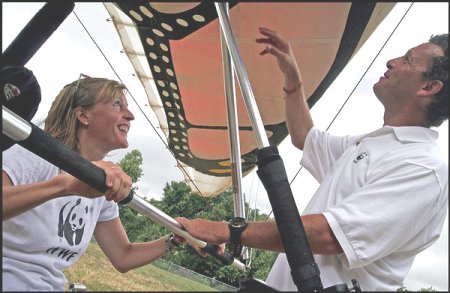|
|
|
|||||



|
"The expert on monarch butterflies stood in a D.C. soccer field yesterday and started to talk about their annual migration and the need to protect their habitat. Suddenly, as if on cue, a lone monarch flitted overhead, a hint of the hundreds of millions that will follow this fall. 'There's a front-runner,' exclaimed Lincoln Pierson Brower, who has been studying the orange-and-black insects for more than a half-century. Every autumn, an estimated 300 million monarch butterflies head south from Canada and the northern United States to winter in California and Mexico. The journey of up to 3,000 miles can last three months. One of the major routes takes them over the Washington area. This year, for the first time, the monarch's transcontinental migration is being tracked and filmed by a crew, using an ultralight plane to make a one-hour documentary about the butterflies, their migration and the challenges they face. The plane, named Papalotzin, which means 'little butterfly' in an Aztec language, is painted to look like a monarch butterfly. It weighs about 397 pounds, has a wingspan of about 33 feet and carries a crew of two -- one to fly and one to film.  'We're not following them, and they're not following us,' said pilot Francisco 'Vico' Gutierrez, who left Toronto late last month. 'We are flying at the same time they leave.' The plane was not allowed to land in Washington. Instead, it landed at Montgomery County Air Park in Gaithersburg and was trucked yesterday to a soccer field at Francis Junior High School in Northwest Washington. It will be on public display Sunday at the National Zoo as part of the animal park's Fiesta Musical celebrating Latin American wildlife and culture. Peak migration for the monarch occurs in late September and early October and follows a route over Maryland and the District. Monarchs usually have a life span of four to five weeks, but those that migrate live seven to eight months. The Papalotzin project is supported by the World Wildlife Fund as well as the Telcel Alliance and the Michoacan state government in Mexico. Its purpose is to learn more about the butterflies' migration and to raise awareness about the need to preserve their winter habitat in Mexico and the wildflowers that sustain them on their journey. 'The massive use of herbicides is killing wildflowers,' said Brower, a biology professor at Sweet Briar College and a senior fellow with the World Wildlife Fund. 'The butterflies come down, and they need the nectar from wildflowers to replenish their energy.' Monarchs are the only butterflies in the world that make such an arduous annual migration, a journey that the World Conservation Union has declared 'an endangered migratory phenomenon,' according to the World Wildlife Fund. In winter, they live in colonies that cluster on fir trees in the pine and oyamel forests of central Mexico. But that habitat is being threatened by illegal logging and other human activities that are thinning the forests, despite the creation in 2000 of the 130,000-acre Monarch Butterfly Biosphere Reserve. The protected area is not federally controlled land but is owned by more than 30 private landlords, most of whom don't live on those properties, said Carlos Galindo-Leal, a conservation ecologist for the wildlife fund in Mexico. This makes it hard to monitor the area for illegal encroachment. Brower, who began studying monarch butterflies at age 23 in 1954, said he has lost none of his enthusiasm for the colorful creatures. He sees them as an ideal way for children to learn about biology, chemistry and conservation. 'There is so much we don't know about them,' he said. 'How high do they fly? How do they know to come back to the same forests each year? Their brain is the size of a pinhead. How do they do it?' The Papalotzin team is keeping a daily blog that details the monarchs'
progress. The journey can be tracked at http://www.papalotzin.com.'"
(Karlyn Barker, The Washington Post, September 16, 2005)
|
